Sustainable Rice–Fish Farming Systems: A Systematic Review and Meta-Analysis
Abstract
The rice–fish farming system is an efficient ecological model with economic, ecological, and social benefits, reduces environmental impacts and optimizes the use of resources. The objective of the research was to explore and analyze scientific publications through a systematic review and meta-analysis related to rice–fish intercropping. A review of publications hosted in the Scopus and PubMed database from January 2000 to April 2025 was conducted. Research articles were selected, excluding review articles, com-mentaries, book chapters, and letters, and only documents published in English were analyzed. The analysis shows that the countries with the highest number of publications were China and Bangladesh, with a proportion of 48% and 24% respectively, followed by Thailand with 10% and Pakistan, Indonesia, Malaysia, and India with 5% each. The fish species used in rice–fish systems were reported to be Cyprinus carpio (37%), Oreochromis niloticus (29%), Barbonymus gonionotus, Micropterus salmoides and Pelteobagrus fulvidraco (8%), Amblypharyngodon mola (5%), and Labeo rohita and Monopterus albus (3%). On average, fish settle in the rice–fish system 27 days after rice planting, with a density of 13,390 fish/ha. Between rice planting and harvesting 132 days pass, obtaining an average yield of 4397 kg of rice/ha and 1383 kg of fish/ha. It is recommended to prioritize integrated research on unstudied fish species, optimal densities, fertilization, culture models, and emerging technologies in rice–fish systems, considering regional variations to improve sustainability, productivity, and food security at a global level.
1. Introduction
More than 50% of the global population depends on rice as a fundamental element in their diet [1, 2]. In 2020, FAO reported that rice production needs to increase by more than 1035 million tons before reaching the year 2050; this will be possible as long as productivity is improved and rice cultivation is diversified and intensified [3]; however, increasing productivity becomes a challenge, as urbanization, industrialization, and the use of agrochemicals have generated several negative impacts on the environment [4, 5]. As a mitigation measure, food systems need to be transformed to minimize environmental impacts, while producing food in the quality and quantity necessary to meet the needs of the world’s population [6, 7]. Thus, integrated agriculture has great potential to emerge as an effective tool for the development of rural economies, due to its profitability, low investment [8], and reduced use of agrochemicals, since these systems reduce pest populations in crops [9].
Integrated agriculture optimizes agricultural production by considering environmental, social, and economic aspects [6, 10, 11], and integrating agricultural practices with activities such as livestock [12], fisheries [13, 14], and forestry [15]. This is the case of integrated rice and fish farming [16], which is an efficient ecological model with economic, ecological, and social benefits [17, 18], reduces environmental impacts and optimizes the use of resources [19].
In this system, fish through their feces contribute nutrients to the soil, which results in the reduction of fertilizer use [20], and the phytoplankton of the rice crop provides food for the fish [21]; in addition, rice–fish contributes to the control of weeds, pests, and diseases in the rice crop [22]. The most commonly used fish in the integrated rice–fish system is Oreochromis niloticus [9, 23–27], Cyprinus carpio [1, 28–30], and Amblypharyngod [31, 32]. This system has become an agricultural production model that employs an ecological cycle and achieves high quality and efficiency [16].
In recent decades, there has been a significant increase in attention to the aquaculture sector due to its key contribution to aquatic food production, which supports individual consumption [9]. In developing countries, freshwater aquaculture plays an important role in providing different nutrients of animal origin [33]. Several studies [34, 35] show that the practice of raising fish in rice fields results in exceptional aquaculture production, increasing farmers’ income. Rice–fish systems has been an established practice in Asian countries for more than 2000 years, as evidenced by examples from Vietnam [36], China [37], Bangladesh [35], and Malaysia [36].
In this context, the research objectives were: (1) To explore and analyze scientific publications through a systematic review and meta-analysis related to rice–fish farming systems, (2) to analyze the impact of rice–fish system on rice yield, and (3) to evaluate trends and suggestions for future research on rice-fish farming.
2. Materials and Methods
2.1. Search Strategy
The systematic review was developed according to the Preferred Reporting Items for Systematic Reviews and Meta-Analyses (PRISMA) guidelines [38]. The Scopus and PubMed databases were used for manuscript selection, since they refer to multidisciplinary scientific literature widely accepted by researchers and include high-impact articles in various areas. The review period was from January 2000 to April 2025, using the search string (TITLE-ABS-KEY (“rice–fish coculture”) OR TITLE-ABS-KEY (“rice–fish farming”) OR TITLE-ABS-KEY (“rice–fish cultivation”) OR TITLE-ABS-KEY (“rice–fish integration”) OR TITLE-ABS-KEY (“rice–fish culture”) OR TITLE- ABS-KEY (“rice–fish culture”) OR TITLE- ABS-KEY (“rice–fish systems”) OR TITLE-ABS-KEY (“rice–fish”) OR TITLE-ABS-KEY (“rice and fish”) OR TITLE-ABS-KEY (“rice–fish coculture”)) for Scopus and “rice–fish coculture” [Title/Abstract]) OR (“rice–fish farming” [Title/Abstract]) OR (“rice–fish cultivation”[Title/Abstract])) OR (“rice–fish integration” [Title/Abstract]) OR (“rice–fish culture”[Title/Abstract]) OR (“rice–fish systems”[Title/Abstract]) OR (“rice–fish” [Title/Abstract]) OR (“rice–fish systems”[Title/Abstract]) OR (“rice–fish coculture”[Title/Abstract]) OR (“rice–fish coculture”[Title/Abstract]) for PubMed. This chain helped to classify and compile the manuscripts that explicitly mention the associated cultivation of rice and fish within the text.
2.2. Inclusion and Exclusion Criteria
The data were filtered using the Scopus and PubMed filtering functions in order to select only research articles, excluding review articles, commentaries, books, book chapters, and letters, and only documents published in English were analyzed. From the previously selected articles, the following were removed: (a) duplicate studies and (b) manuscripts published in a manner other than open access mode. After applying these selection criteria, 961 manuscripts were selected (Figure 1).
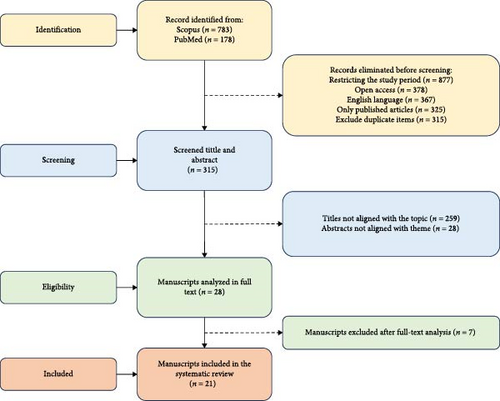
In the selected manuscripts, the title was analyzed independently in order to determine the existence of relationships with the objective of the study, leaving 315 manuscripts for analysis of the abstract. After the analysis of the abstract, 28 manuscripts remained in which the full text was analyzed in order to determine whether the contribution to this work could be useful for the fulfillment of the research objective. Finally, after an exhaustive review of each article, 21 articles remained for analysis.
2.3. Data Analysis
Bibliometrix software [39] was used to analyze scientific production by country, while VOSviewer software, a data mining tool used in systematic review studies, was used to analyze journal co-citation and word co-occurrence [40].
3. Results
3.1. Bibliometric Analysis
The results of this review are approached from a temporal and geographic perspective and are summarized in several graphs of relevant information, including years of publication, countries where the studies were conducted, keyword analysis, and authors’ network.
3.2. Analysis of Scientific Production
The 21 manuscripts considered in the systematic review are published in 15 different scientific journals. Of these, 20 were cited at least once. The three journals with the highest number of publications are Aquaculture research (three), Scientific reports (three), Agronomy (two) and Aquaculture Reports (two; Table 1). In this sense, it is evident that the main contributions related to rice associated culture are not limited only to journals specialized in aquaculture, but to more transdisciplinary journals.
| Source | Documents | Citations | Quartiles | Scientific journal rankings |
|---|---|---|---|---|
| Aquaculture Research | 3 | 113 | Q2 | 0.53 |
| Scientific Reports | 3 | 47 | Q1 | 0.9 |
| Agronomy | 2 | 12 | Q1 | 0.69 |
| Aquaculture Reports | 2 | 51 | Q1 | 0.82 |
| Agriculture (Switzerland) | 1 | 2 | Q1 | 0.61 |
| Animals | 1 | 15 | Q1 | 0.7 |
| Antioxidants | 1 | 34 | Q1 | 1.484 |
| Egyptian Journal of Aquatic Biology and Fisheries | 1 | 10 | Q3 | 0.24 |
| Fishes | 1 | 2 | Q2 | 0.523 |
| Frontiers in Environmental Science | 1 | 5 | Q2 | 0.72 |
| Indian Journal of Animal Research | 1 | 0 | Q3 | 0.214 |
| Microbiome | 1 | 8 | Q1 | 3.8 |
| PLoS ONE | 1 | 4 | Q1 | 0.84 |
| Sustainability (Switzerland) | 1 | 9 | Q1 | 0.67 |
| Water (Switzerland) | 1 | 1 | Q1 | 0.752 |
Quantitative analysis of global scientific production on associated rice–fish farming revealed that China and Bangladesh were the main contributors with 48% and 24%, respectively, followed by Thailand with 10% and Pakistan, Indonesia, Malaysia, and India with 5% each (Figure 2).
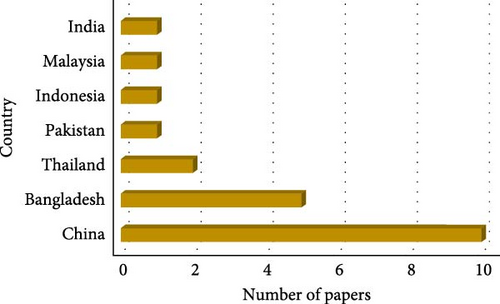
3.3. Contribution of the Journals
The journals were evaluated according to the number of publications and the Scimago Journal and Country Rank (SJR). Of the 21 articles selected, 15 journals published them. Table 1 shows the journals, their quartile, the number of citations, and their quartile. The results indicate that 67% of the journals belong to the first quartile, 20% to the second quartile, and 13% to the third quartile. Aquaculture Research and Scientific reports has the highest number of publications (three articles) followed by Agronomy and Aquaculture Reports, with two publications each. The articles have a total of 313 citations, with an average of 21 citations per article.
3.4. Keyword Co-Occurrence Analysis
The keyword co-occurrence analysis reveals the presence of four clearly defined thematic clusters. The light green cluster, located in the center-left part of the map, groups terms such as aquaculture, metabolism, microbial community, intestinal microbiota, amino acid, bacteria, and growth rate. This cluster is related to studies focused on physiology, metabolism, and microbiology in aquaculture systems, particularly in cultured fish. On the other hand, the blue cluster, located on the right, is made up of terms such as cyrinid, stocking density, plankton, fertilizer application, and eutrophia. This cluster represents research focused on ecological aspects, such as planting density, water quality, and trophic effects in integrated rice–fish systems. In the yellow cluster, located on the upper right, terms such as sustainable agriculture, soil fertility, cocultures, and paddy field are highlighted. This cluster reflects an emerging line of research oriented towards sustainability, soil fertility, and agroecology in rice fields integrated with aquaculture. The central core of the network is dominated by terms such as rice, water quality, fish, and nitrogen, which function as nodes connecting the different clusters. Their strategic position highlights their transversal role in multiple lines of research, acting as articulating axes within a multidisciplinary approach (Figure 3).
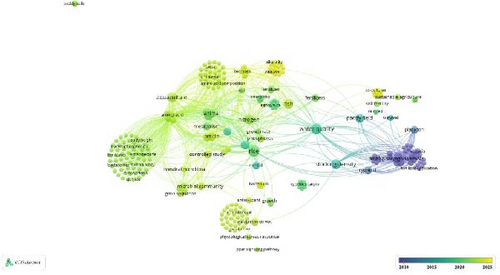
3.5. Co-Citation of Sources
The central and largest node corresponds to the journal Aquaculture, which evidences its role as the most cited and influential source in the field of aquaculture research. Its strategic position, with numerous connections to various scientific publications, indicates that it acts as an articulating axis and transversal source for multiple lines of study within the field. The green cluster (located in the center of the network) integrates journals such as Aquaculture, Plos One, Hydrobiologia, Frontiers in Microbiology, Chinese Agricultural Science B, and Ecology. This cluster represents the consolidated core of aquaculture research, characterized by its interconnection with complementary areas such as microbiology, environmental sciences, and aquatic biology. The high density of connections suggests a thematic and methodological consolidation in these domains. The red/orange cluster (lower left) groups publications such as Agronomy, Water, Scientific Reports, and Biodiversitas. This cluster represents a research strand linking aquaculture with agriculture, biodiversity, and, agroecological approaches. It suggests an increasing integration between aquatic and terrestrial production systems, as well as a holistic approach to sustainability. The light blue cluster (lower right) includes journals such as Science of the Total Environment, Microbiome, and Frontiers in Microbiology. This cluster is associated with research oriented to water quality, ecological interactions, and microbial health in aquatic systems, reflecting an environmental and ecosystem perspective in the study of aquaculture. The yellow cluster (located on the right) is composed of Aquaculture Research and associated publications. It represents a subfield focused on aquaculture production, addressing technological, nutritional, and performance evaluation aspects of culture systems. Finally, the pink cluster (upper right) includes journals such as Aquaculture Reports and Ecology. Although less central, this cluster alludes to more specific or emerging lines of research within the field, possibly linked to applied ecological studies and innovative approaches in aquaculture (Figure 4).
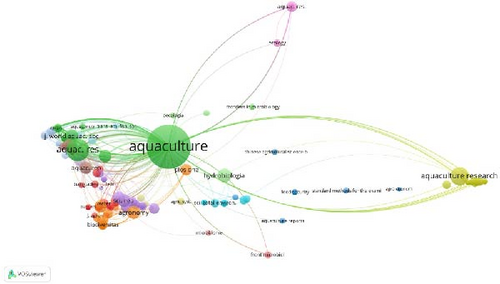
3.6. History of Publications and Publishing Houses
It is evident that according to the search string and restrictions applied in this review, the first publications date back to 2008. The country with the most publications is China. The most frequently published publishers are MDPI and Hindawi. Regarding the H-index of the journals, PLos ONE stands out with 435, followed by Scientific Reports with 315, Sustainability (Switzerland) with 160, and Microbiome with 143 (Table 2).
| Year | Country | Title | Publisher | Source title | h-index | Reference |
|---|---|---|---|---|---|---|
| 2008 | Bangladesh | Evaluation of freshwater prawn-small fish culture concurrently with rice in Bangladesh | Wiley | Aquaculture Research | 106 | [32] |
| 2008 | Bangladesh | Potential of mixed culture of freshwater prawn (Macrobrachium rosenbergii) and self-recruiting small species mola (Amblypharyngodon mola) in rotational rice-fish/prawn culture systems in Bangladesh | Wiley | Aquaculture Research | 106 | [31] |
| 2009 | Bangladesh | Effects of including catla and tilapia in a freshwater prawn-mola polyculture in a rotational rice–fish culture system | Wiley | Aquaculture Research | 106 | [24] |
| 2020 | China | Effects of introducing eels on the yields and availability of fertilizer nitrogen in an integrated rice–crayfish system | Nature Research | Scientific Reports | 315 | [41] |
| 2020 | China | Effect of introducing frogs and fish on soil phosphorus availability dynamics and their relationship with rice yield in paddy fields | Nature Research | Scientific Reports | 315 | [25] |
| 2020 | Malasia | Impact of feeding schedule on the growth performances of tilapia, common carp, and rice yield in an integrated rice-fish farming system | MDPI | Sustainability (Switzerland) | 160 | [23] |
| 2020 | Bangladesh | Growth and economics of silver barb (Barbonymus gonionotus) in rice–fish–vegetable integrated culture system at different stocking densities in a rainfed arid zone | Egyptian Society for the Development of Fisheries and Human Health | Egyptian Journal of Aquatic Biology and Fisheries | 18 | [42] |
| 2020 | China | Effect of introducing frogs and fish on soil phosphorus availability dynamics and their relationship with rice yield in paddy fields | Nature Research | Scientific Reports | 315 | [41] |
| 2021 | Thailand | Growth and feeding behavior of fishes in organic rice–fish systems with various species combinations | Elsevier BV | Aquaculture Reports | 42 | [29] |
| 2021 | China | Biodiversity and sustainability of the integrated rice–fish system in Hani terraces, Yunnan province, China | Elsevier BV | Aquaculture Reports | 106 | [43] |
| 2022 | China | Rice flowering improves the muscle nutrient, intestinal microbiota diversity, and liver metabolism profiles of tilapia (Oreochromis niloticus) in rice–fish symbiosis | BioMed Central Ltd | Microbiome | 143 | [26] |
| 2022 | China | Rice–fish–duck system regulation of soil phosphorus fraction conversion and availability through organic carbon and phosphatase activity | Frontiers Media S.A. | Frontiers in Environmental Science | 77 | [26] |
| 2022 | India | Relative growth performance of Cyprinus carpio and Labeo rohita vis-à-vis their improved strains in integrated rice–fish culture system at high altitude terraced paddy fields | Agricultural Research Communication Centre | Indian Journal of Animal Research | 20 | [44] |
| 2022 | China | Effects of stocking density on the growth performance, physiological parameters, redox status and lipid metabolism of Micropterus salmoides in Integrated rice–fish farming systems | MDPI | Antioxidants | 133 | [45] |
| 2023 | Pakistan | Optimizing rice–fish coculture: Investigating the impact of rice spacing density on biochemical profiles and production of genetically modified tilapia (Oreochromis spp.) and Cyprinus carpio | Public Library of Science | PLoS ONE | 435 | [9] |
| 2023 | China | Evaluating rice varieties for suitability in a rice–fish Coculture system based on lodging resistance and grain yield | MDPI | Agronomy | 91 | [1] |
| 2023 | China | Effects of stocking density on the growth performance, physiological parameters, antioxidant status and lipid metabolism of Pelteobagrus fulvidraco in the integrated rice–fish farming system | MDPI | Animals | 75 | [16] |
| 2023 | Indonesia | The integrated Minapadi (rice–fish) farming system: compost and local liquid organic fertilizer based on multiple evaluation criteria | MDPI | Agronomy | 91 | [27] |
| 2023 | Bangladesh | Integration of vegetables and fish with rice in rain-fed farmland: towards sustainable agriculture | MDPI | Agriculture (Switzerland) | 66 | [28] |
| 2024 | China | Effects of different stocking densities on the growth, antioxidant status, and intestinal bacterial communities of carp in the rice–fish coculture system | MDPI | Fishes | 29 | [16] |
| 2024 | Tailandia | Changes in water quality and soil property in the rice–freshwater animal coculturing system | MDPI | Water (Switzerland) | 123 | [46] |
3.7. Data Collected From Articles Included in the Study
The fish species used in the rice-fish systems are C. carpio (37%), O. niloticus (29%), Barbonymus gonionotus, Micropterus salmoides and Pelteobagrus fulvidraco (8%), A. mola (5%), and Labeo rohita and Monopterus albus (3%). On average, fish settle in the rice–fish system 27 days after rice planting. Between rice planting and harvesting, 132 days elapse and fish are harvested at 95.9 days. Fish planting density per hectare is mainly related to the fish species. For the case of this review, the average planting density was 13,390 fish/ha, finally the average rice yield obtained was 4397 and 1393 kg/ha of fish (Table 3). It should be noted that P. fulvidraco data were not considered when calculating the mean density of fish/ha, rice yield, and fish yield (kg/ha).
| Fish species | Installation of fish after rice planting (day) | Duration of rice trial (days) | Duration of fish trial (days) | Average initial fish weight (g) | Final average weight of fish (g) | Weight gain (%) | Fish density (ha) | Rice yield (kg/ha) | Reference |
|---|---|---|---|---|---|---|---|---|---|
| Amblypharyngodonmola | 25 | 152 | 140 | 1.24 | 3.55 | 286.29 | 20,000 | 3710.00 | [31, 32] |
| Barbonymus gonionotus | 16 | 121 | 106 | 10.04 | 93.91 | 935.36 | 10,000 | 4492.50 | [42] |
| Cyprinus carpio | 19 | 111 | 91 | 44.09 | 158.40 | 359.27 | 14,082 | 4782.10 | [1, 26, 28, 29] |
| Labeo rohita | 30 | 123 | 90 | 7.00 | 57.28 | 818.29 | 6000 | 2384.00 | [44] |
| Micropterus salmoides | 45 | 125 | 92 | 40.63 | 243.09 | 598.30 | 20,000 | ND | [16] |
| Monopterus albus | 31 | 168 | 76 | 21.40 | 41.67 | 194.70 | 12,000 | 6100.00 | [41] |
| Oreochromis niloticus | 26 | 133 | 97 | 23.67 | 278.49 | 1176.55 | 11,650 | 4915.60 | [9, 23–27] |
| Pelteobagrus fulvidraco | 24 | 123 | 75 | 0.36 | 61.26 | 17,016.67 | 5,160,000 | ND | [16] |
- Note: ND, data not available.
3.8. Trends and Suggestions for Future Research on Rice-Fish
The bibliometric study conducted with the RStudio program (Bibliometrix) [39] indicates a thematic evolution from traditional water quality concerns towards more integrative approaches combining productivity (rice and fish), sustainability (nitrogen and oryza), and target species (tilapia). This dynamic suggests a diversification of the field towards more ecological and technified production models, where interactions between biotic and abiotic components are key. Overall, it shows how integrated rice–fish systems have been consolidated as a relevant model of study, with increasing attention to their environmental impact, nutritional efficiency, and agronomic potential (Figure 5).
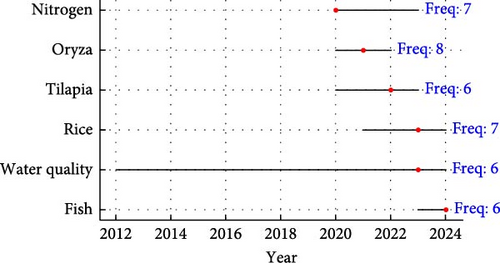
- •
Investigate the impact of previously unstudied fish species within rice–fish farming systems. This could involve evaluating their growth, yield, and effects on water and soil quality.
- •
Conduct detailed studies to determine the optimal fish population density in rice–fish systems. The aim would be to maximize yields for both rice and fish, considering variations in fish species and local conditions.
- •
Analyze the long-term effects of using organic and inorganic fertilizers on soil quality and crop yields in rice–fish farming systems. This research could help develop more sustainable and efficient practices.
- •
Compare different rotation and polyculture models, such as introducing juvenile fish after the rice harvest or simultaneous planting of rice and fish. This would help identify the most effective methods in terms of productivity and sustainability.
- •
Investigate the environmental impact of rice–fish farming systems, including nutrient balance, biodiversity, and carbon cycling. Understanding these factors could shed light on how these systems interact with and influence the surrounding ecosystem.
- •
Expand research to different regions worldwide to understand how climatic and geographical variations affect the application and outcomes of rice–fish farming systems.
- •
These research areas aim not only to improve the understanding and application of rice–fish farming systems but also to contribute to global sustainability and food security.
4. Discussion
The rice–fish farming systems is the world’s oldest integrated aquaculture system in the world [47], and different fish species have been used, for example, Ctenopharyngodon idella, C. carpio, Misgurnus anguillicaudatus), Aristichthys nobilis, and Oreochromis sp. [48], for the case of this research it was observed that C. carpio and O. niloticus are the most used species in rice–fish farming systems research with 37% and 29%, respectively.
Of the 117 rice-producing countries, 40% have applied some model of integrated rice-based farming [49]. According to the results obtained in the review, China and Bangladesh are the countries with the highest number of publications related to integrated rice–fish farming as evidenced in other studies [50]. China is one of the countries that has promoted and implemented these systems more than 2000 years ago [49, 51]. In recent decades, rice–fish in China has shifted from a production-centered approach to an ecological model [52], standing out for developing this farming system in large extensions, in addition to having political, financial, and technical support, thus, developing rice varieties adapted to fish-associated farming. However, in Latin America and Africa, no scientific literature related to the topic of study was found, although this does not imply that these types of practices do not exist, but rather that there is a lack of research and scientific documentation, and adoption in these regions could be limited by the lack of technical knowledge, agricultural policies oriented to monoculture, and scarce investment in agroecological research.
According to the research, it is observed that rice–fish farming systems has been a traditional practice in many Asian farming communities; however, its scientific recognition and technical improvement have been developed in the last two decades. Initially, this system has been seen as a subsistence system, and in recent years, it has been revalued for its potential to reduce the use of agrochemicals, improve agroecosystem biodiversity, and increase long-term profitability [9, 53], which has led to an increase in the number of scientific publications from 2010 onwards, gaining interest as a tool for climate change adaptation.
Rice–fish is developed in two ways; either through rotations between rice and fish or in the form of coculture of rice and fish; the first method involves introducing juvenile fish after rice harvest or planting rice after harvesting fish; the second system, is based on the introduction of juvenile fish (fry) for simultaneous culture with rice and at the end collect adult fish before rice harvest [49], in this case, the fish are planted 27 days after the rice is installed, with an average harvest time of 132 days according to the results of this review.
An average stocking rate of 13,390 fish/ha was determined, several studies have reported the impact of stocking density on the decrease of water quality when fish are reared in ponds [54]; however, in rice–fish systems, water quality is not affected [55], this is attributed to the rice crop absorbing the nutrients released in the fish excreta [56], for example, during the tillering stage, rice tends to assimilate large amount of N and P, consequently, it is going to reduce the load of these nutrients in both water and soil [57, 58]; furthermore, fish stocking density significantly influences its growth [59], although high densities are often considered to be a form of better use of water and land resources, this practice does not necessarily lead to better productivity [16].
Regarding rice yield, this review showed a yield of 4397 kg/ha, in a general way; rice yield is directly related to the applied nitrogen dose [60–62], thus, for a low nitrogen dose, yield varies from 5000 to 7000 kg/ha, for a medium nitrogen dose it ranges from 7000 to 11,000 kg/ha and for a high dose, yield ranges from 9000 to 15,000 kg/ha [63] to the conditions of rice-fish which is generally developed under organic models, it is to understand the productivity found in this review, since the release of nitrogen available to rice seedlings from organic fertilizers is slow, and that it does not usually supply the nitrogen demand in the growth period of plants [64], on the other hand, the input of nitrogen fertilizers from inorganic sources for a long time damages soil structure, decreasing the quality of arable soils [65], disfavoring sustainability in rice production [60].
However, the model of rice cultivation associated with fish, in addition to rice production, also adds fish farming, reaching up to 940 kg/ha [66, 67], for the case of this review, an average yield of 13,390 kg/ha was observed, this leads to obtaining better economic income for farmers [68, 69], in addition to the fact that in the framework of food security, the value of rice and fish produced under rice–fish are usually higher than those generated through traditional models [49, 70] contributing to food security, rural livelihoods, economic development, and environmental protection [49].
Therefore, in order to ensure the adoption and continuity of these agricultural practices, it is necessary to develop specific policies and funding to accelerate the adoption of crop diversification [71]; however, different countries lack technical, scientific, and/or financial support to promote diversification [72], in addition to which the edaphoclimatic variations caused by climate change have an influence on the viability of diversified systems [73]. Finally, although there are multiple advantages regarding crop diversification, in particular with rice–fish farming systems, it is not a universal solution, the economic, social, and ecological constraints should be considered and addressed through specific interventions [71].
The limitations of this study include the use of only two databases (Scopus and PubMed), the selection of only scientific research published in open access and in English, although this could have limited the inclusion of other studies [74], it is worth noting that most of the high impact and widely disseminated articles are published in English, which facilitates the comparison between studies. Furthermore, it has been reported that although excluding publications written in a language other than English may induce bias; in many cases it does not have a significant effect on the main conclusions of systematic reviews [75, 76]. Nevertheless, this choice is acknowledged as a potential limitation, which has been transparently stated and will be addressed in future research by expanding sources and linguistic criteria. Despite this, this research provides valuable information for agricultural professionals and decision makers on the rice–fish farming system, associated crop productivity, and future trends. This framework should be refined and expanded through long-term practices and trials, analysis of production scale and geographic location, and widespread adoption of this cropping system in areas where rice thrives.
5. Conclusions
This study confirms that integrated rice–fish systems are a viable agricultural strategy to promote environmental sustainability, food security, and local socioeconomic development. However, there are vast gaps in the current available literature, particularly with respect to long-term assessment of the systems, accurate determination of ecosystem services generated, and variable socioeconomic impacts by gender, scale of production, and geographic location, among others. There is an urgent need for standardization of sustainability assessment methods and a greater proportion of comparative analyses between regions and between anthropic and conventional systems.
- 1.
Longitudinal assessments that examine the economic and ecological sustainability of the rice–fish system over time.
- 2.
Transferability analyses in order to better understand how these systems can be adapted to diverse socioeconomic and ecological contexts.
- 3.
Participatory studies and transdisciplinary approaches that integrate local knowledge, agricultural policies, and rural development economics to facilitate successful implementation.
- 4.
Evidence-based public policies that support the growth of rice–fish farming through subsidies, training, and legal frameworks, especially in vulnerable rural communities.
Promoting research in these areas will not only increase the efficiency and resilience of rice–fish systems, but also consolidate them as a crucial solution to global food insecurity, biodiversity loss, and climate change.
Conflicts of Interest
The authors declare no conflicts of interest.
Author Contributions
Franklin Fernandez-Zarate, Luis Pérez-Delgado, David Coronel-Bustamante, and Leisy Huanca-Silva: supervision, conceptualization, manuscript writing, and revision. Alejandro Seminario-Cunya, Daniel Tineo-Flores, Darwin Gomez-Fernandez, and Malluri Goñas-Goñas: manuscript writing, revision, and editing. Victor H. Taboada-Mitma and Juancarlos Cruz-Luis: review and fund raising. Mariela Quispe-Carhuapoma, Yashira Oliva-Alvarez, Maximo Ramirez-Antaurco, Janella Anchayhua-Torres, and Annick Estefany Huaccha-Castillo: methodology, review, and data collection.
Funding
This study was financed by the Instituto Nacional de Innovacion Agraria through the investment project identified with CUI 2472675 called: “Improvement of research services and agricultural technology transfer at the Baños del Inca Agricultural Experimental Station in the Town of Los Baños del Inca in the District of Los Baños del Inca, Province of Cajamarca, Department of Cajamarca.”
Open Research
Data Availability Statement
The data that support the findings of this study are available from the corresponding author upon reasonable request.




